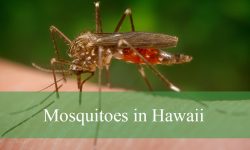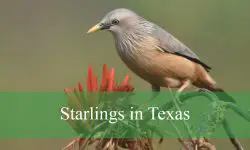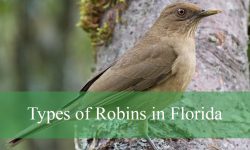Owls in Alaska are fascinating creatures that capture the imagination of birdwatchers and nature enthusiasts alike. With their mysterious calls and silent flight, these nocturnal predators play an important role in the diverse ecosystems across the state. Alaska’s vast wilderness provides a perfect habitat for a variety of owl species, making it a prime location for owl spotting.
The state of Alaska is home to a unique mix of owls, ranging from the large and powerful Great Horned Owl to the tiny and elusive Northern Pygmy Owl. Each species has its own distinct characteristics, behaviors, and preferred habitats, reflecting the incredible adaptability of owls in this rugged environment. Whether you are an experienced birder or a curious beginner, learning about owls in Alaska offers a rewarding glimpse into the wild.
In this article, we will explore 14 types of owls in Alaska, complete with pictures and identification tips. From the iconic Snowy Owl of the Arctic tundra to the secretive Flammulated Owl of southern pine forests, this guide will help you recognize and appreciate these amazing birds. Get ready to discover the remarkable world of owls in Alaska!
Different Types of Owls Found in Alaska
Great Horned Owl (Bubo virginianus)
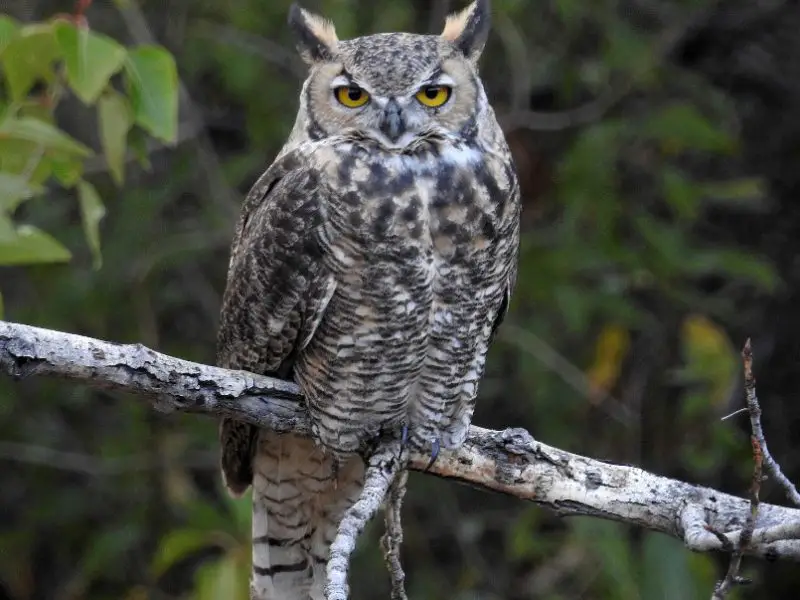
The Great Horned Owl is one of the most widespread and familiar owl species in Alaska. It is a large, powerful bird characterized by its prominent ear tufts, yellow eyes, and a deep hooting call. Its plumage is mottled brown and gray, which provides excellent camouflage in various habitats.
This owl is easily identified by its distinctive “hoo-hoo-hoo” call, often heard at dusk and night. It has a robust body with broad wings and a short tail, making it a skilled and silent hunter. The Great Horned Owl’s facial disk is not as pronounced as some other owls, but its fierce gaze and large size make it unmistakable.
Behaviorally, the Great Horned Owl is a nocturnal predator that feeds on a wide range of prey, including mammals, birds, and even reptiles. It is known for its adaptability and aggressive nature, able to hunt in forests, mountains, and open areas. It often nests in abandoned nests of other large birds or natural tree cavities.
In Alaska, the Great Horned Owl inhabits diverse environments, ranging from dense forests to tundra edges and mountainous regions. It is found throughout most of the state, thriving in areas with adequate prey and nesting sites. Its wide distribution and versatile habits make it the most common owl species in Alaska.
Barred Owl (Strix varia)
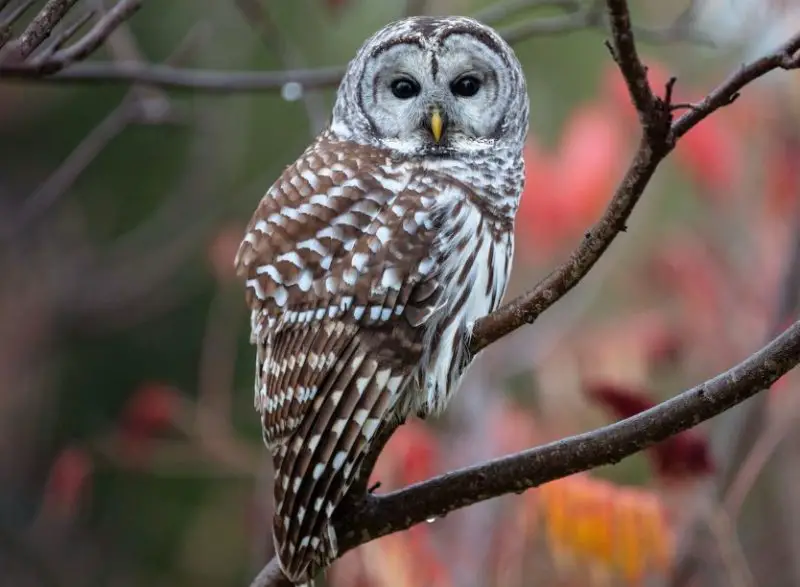
The Barred Owl is known for its distinctive vertical and horizontal barring patterns on its chest and belly, which give it its name. It has a rounded head without ear tufts and dark eyes, setting it apart from other owl species. Its brown and white plumage blends well with the forest environments where it lives.
One of the most recognizable features of the Barred Owl is its call, often described as sounding like “Who cooks for you? Who cooks for you all?” This repetitive hooting is commonly heard during the evening and night, making the owl easier to detect despite its secretive nature.
Barred Owls are primarily nocturnal but sometimes are active at dusk and dawn. They feed on a variety of prey, including small mammals, birds, amphibians, and insects. They prefer dense, mature forests with abundant water sources and tend to nest in large tree cavities or old nests of other birds.
In Alaska, Barred Owls are commonly found in moist forests, especially in the southern and southeastern parts of the state. Their preference for wooded wetlands and old-growth forests makes them an important part of the ecosystem, contributing to the balance of local prey populations.
Northern Saw-whet Owl (Aegolius acadicus)
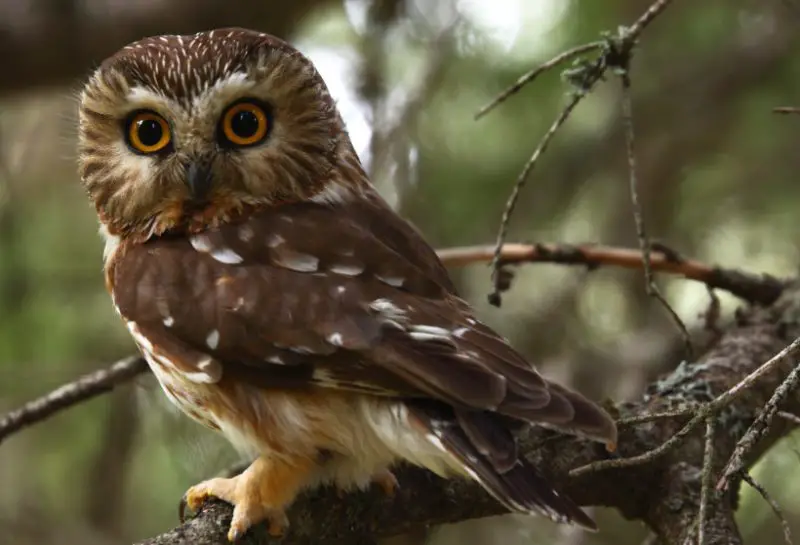
The Northern Saw-whet Owl is a small, compact owl species, measuring only about 7 to 8 inches in length. It has a rounded head without ear tufts and large yellow eyes that give it a curious appearance. Its plumage is brown with white spots, aiding camouflage in dense forest habitats.
This owl’s call is a high-pitched, repetitive tooting sound that resembles the noise of a saw being sharpened, which is how it gets its name. The call is most often heard at night during the breeding season, used to attract mates and establish territory.
Northern Saw-whet Owls are strictly nocturnal and hunt mainly small rodents and insects. They are known for their secretive and shy behavior, often roosting in dense coniferous or mixed forests during the day. Their small size allows them to navigate thick underbrush and dense woodlands.
In Alaska, this owl is typically found in mature forests with ample cover, especially in the southern and central regions. Its distribution covers much of the state but it is less common in open tundra areas. The Northern Saw-whet Owl plays a vital role in controlling rodent populations in its habitat.
Snowy Owl (Bubo scandiacus)
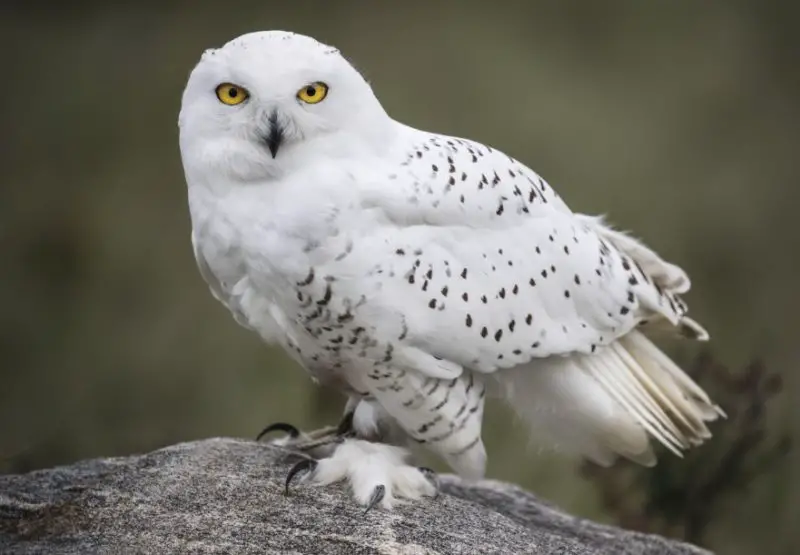
The Snowy Owl is one of the most iconic birds of the Arctic and sub-Arctic regions, known for its striking white plumage that helps it blend into snowy landscapes. Males tend to be almost pure white, while females and younger birds have more dark spots and bars. It is a large, powerful owl with yellow eyes and a rounded head.
Snowy Owls have a unique, deep hooting call but can also produce hissing and clicking sounds. Unlike many owls, they are often active during the day, especially in the bright Arctic summer. Their behavior is adapted to open tundra and icy environments where they hunt.
They primarily feed on lemmings and other small mammals but will also take birds. Snowy Owls are strong hunters, capable of flying long distances across tundra and coastal regions. They nest on the ground in open areas, which makes their white plumage an effective camouflage.
In Alaska, Snowy Owls are most commonly seen in the northern and western coastal tundra regions. They often move southward in winter, appearing more frequently in open fields and along shorelines. Their presence is an important indicator of Arctic ecosystem health.
Short-eared Owl (Asio flammeus)
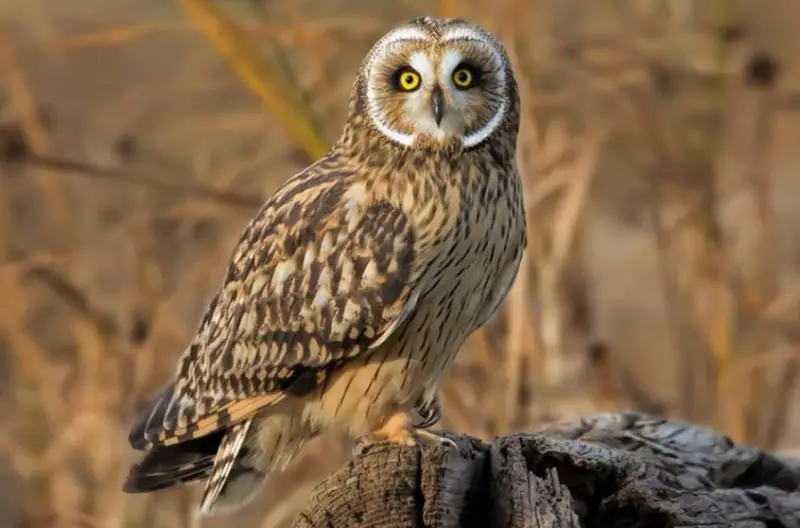
The Short-eared Owl is a medium-sized owl with distinctive short ear tufts that are often hard to see. Its plumage is mottled brown and buff with streaks, allowing it to blend well with grasslands and open habitats. It has large yellow eyes set in a round facial disk.
This owl is known for its unusual habit of hunting during the day and at dusk, unlike many other owl species. Its call is a series of low, muffled hoots and barks, often heard during flight as it patrols open fields in search of prey.
Short-eared Owls primarily feed on small mammals like voles and mice. They are strong and agile flyers, often seen flying low over grasslands and marshes. Their nesting usually occurs on the ground in dense vegetation, making their camouflage essential for protecting eggs and chicks.
In Alaska, the Short-eared Owl prefers open tundra, grasslands, and marshy areas. It is more common in coastal regions and river valleys where prey is abundant. Their daytime hunting behavior makes them more visible than many other owl species in Alaska.
Northern Hawk Owl (Surnia ulula)
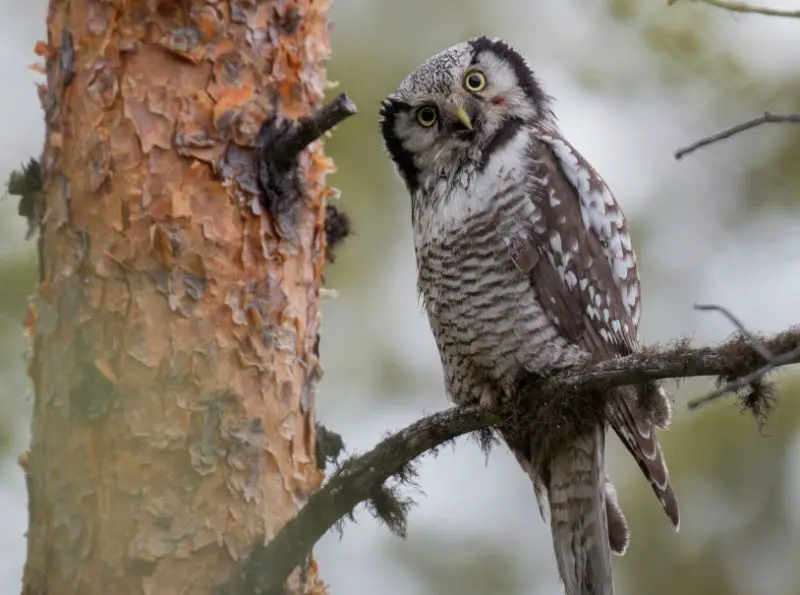
The Northern Hawk Owl is a diurnal predator known for its daytime hunting habits, which is unusual among owls. It has a long tail and a rounded head without ear tufts, with striking yellow eyes and barred plumage that helps it blend into its environment. Its sleek body shape resembles that of a hawk, which inspired its name.
This owl is identified by its sharp, clear calls that sound like a series of rapid whistles. Unlike many owls, it often hunts by perching high on trees and scanning open areas for small mammals and birds during daylight hours. Its excellent eyesight and keen hearing make it an effective hunter in the forests.
Northern Hawk Owls typically hunt small rodents, such as voles and mice, and sometimes birds. Their hunting style involves swooping low to the ground from a perch, combining patience and precision. They are highly territorial and use vocalizations to communicate during the breeding season.
In Alaska, this species prefers mixed forests and boreal woodland habitats, particularly where there are open spaces for hunting. They are distributed mainly in the interior and northern parts of the state, thriving in cold, forested environments with abundant prey.
Great Gray Owl (Strix nebulosa)
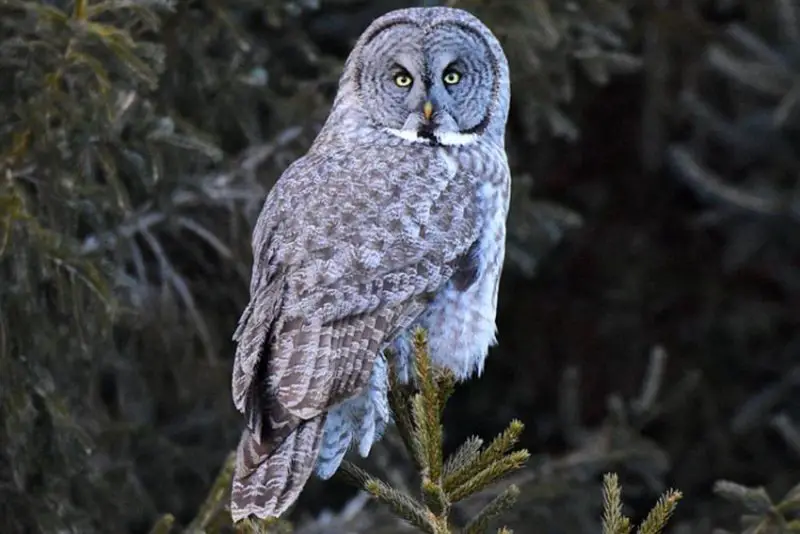
The Great Gray Owl is the largest owl species by length in North America, recognized for its massive, round face and striking gray plumage with intricate patterns. Its large yellow eyes are framed by concentric circles of feathers, giving it a distinctive appearance. Despite its size, it has a soft, fluffy look due to dense feathers.
Its call is a low, deep hoot, often heard echoing through the taiga forests where it lives. Great Gray Owls are primarily nocturnal but can also be active during the day, especially in the low-light conditions of the boreal forest.
This owl feeds mainly on small mammals like voles and mice, relying on acute hearing to detect prey beneath snow or dense vegetation. It hunts by perching silently before swooping down on unsuspecting prey. The Great Gray Owl nests in old nests of other large birds or on broken tree trunks.
In Alaska, the Great Gray Owl inhabits the taiga forest biome, mainly in the interior regions with dense coniferous trees. It prefers remote, mature forests with a mix of open areas for hunting and thick cover for nesting, making it a fascinating but elusive species to spot.
Boreal Owl (Aegolius funereus)
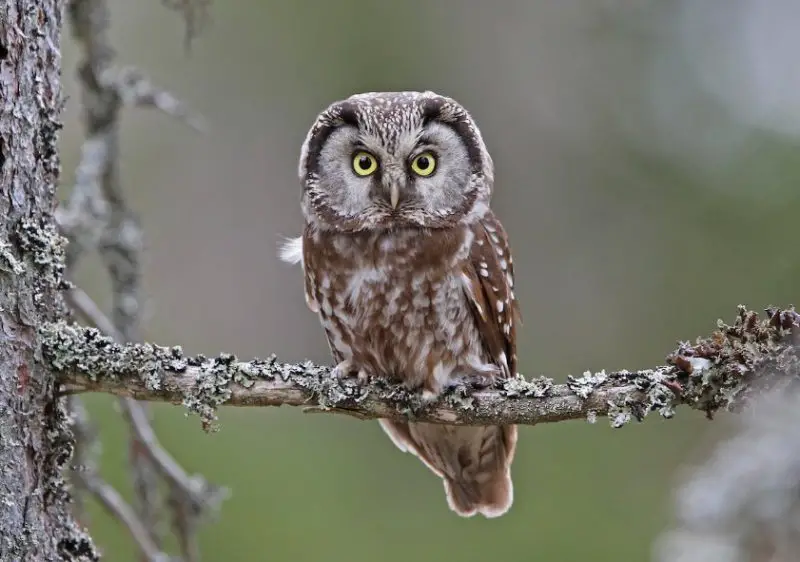
The Boreal Owl is a small, nocturnal species that dwells deep within boreal forests. It is similar in size to the Northern Saw-whet Owl but has a more rounded head and lacks prominent ear tufts. Its plumage is brown with white spots on the head and back, and it has bright yellow eyes.
This owl’s call is a series of rapid, high-pitched toots that can be heard at night during the breeding season. The Boreal Owl is secretive and difficult to observe, preferring dense, mature forests where it roosts quietly during the day.
Boreal Owls feed primarily on small mammals such as voles, mice, and occasionally birds. They hunt by flying low and silently through the forest, using keen hearing to locate prey under snow or leaf litter. Nesting usually occurs in tree cavities or old woodpecker holes.
In Alaska, the Boreal Owl is found mainly in deep boreal forests, particularly in the central and northern regions. It is less common than other owl species but plays a vital role in the forest ecosystem by controlling small rodent populations.
Long-eared Owl (Asio otus)

The Long-eared Owl is easily recognizable by its prominent ear tufts, which resemble long “horns” and give the species its name. It has mottled brown and buff plumage that provides excellent camouflage among tree branches. Its orange eyes stand out against its facial disk.
This owl is mainly nocturnal and known for its soft, low hoots that can be heard during the breeding season. Its elusive nature and effective camouflage make it difficult to spot during the day when it roosts quietly in dense trees or shrubs.
Long-eared Owls primarily feed on small mammals, especially rodents. They hunt mostly at night by silently flying through forest edges and open woodlands. They nest in abandoned nests of other birds, often in dense wooded areas or near human settlements.
In Alaska, the Long-eared Owl inhabits forests and suburban areas with sufficient tree cover. It is distributed throughout parts of the state where forests are mixed with open spaces, favoring quiet, undisturbed habitats for nesting and hunting.
Western Screech-Owl (Megascops kennicottii)
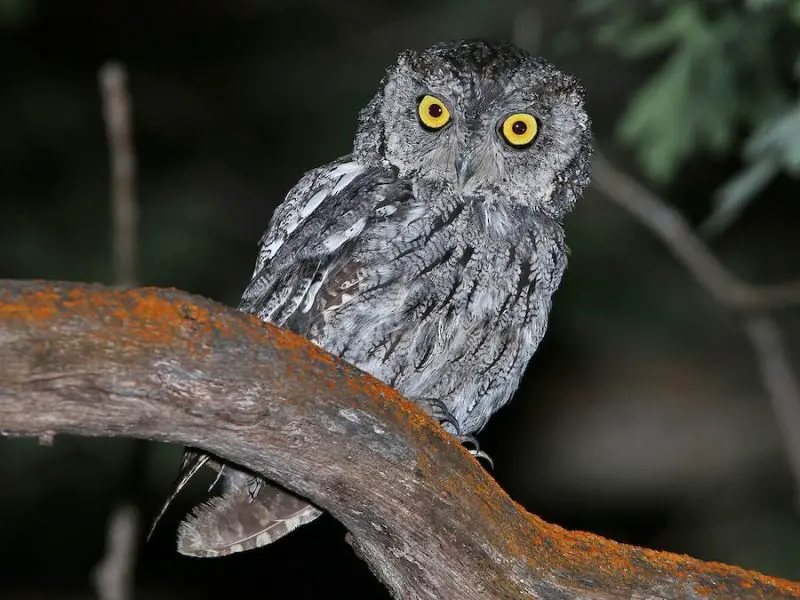
The Western Screech-Owl is a small owl species with a compact body and ear tufts that give it a distinctive silhouette. Its plumage is mottled gray or brown, blending well with tree bark. It has yellow eyes and a facial disk with subtle markings.
Its vocalizations consist of a series of short, accelerating trills or whistles, often described as a “screech,” which is used for communication during breeding and territorial defense. The call can be heard mostly at night, although this owl can sometimes be active at dusk.
Western Screech-Owls feed on small mammals, insects, and occasionally small birds. They are agile hunters, able to maneuver through dense foliage in suburban woodlands and forest edges. They nest in tree cavities or nest boxes, often near human habitations.
In Alaska, the Western Screech-Owl is commonly found in forested areas near urban and suburban regions, especially in the southern parts of the state. It prefers open woodlands and forest edges, adapting well to human presence while maintaining a secretive lifestyle.
Flammulated Owl (Psiloscops flammeolus)

The Flammulated Owl is a small, nocturnal species known for its quiet nature and subtle, flame-like facial markings. It is one of the tiniest owls in North America, with a soft, brownish-gray plumage that helps it blend into dry pine forests. Its small size and cryptic coloring make it difficult to spot.
This owl is mostly active at night, producing a low, repetitive “hoo” call that carries softly through the dry coniferous woods where it lives. It uses its vocalizations mainly during the breeding season to establish territory and attract mates. Its elusive behavior means sightings are very rare.
The Flammulated Owl feeds primarily on insects, such as moths and beetles, which it catches in flight using its agile wings and sharp talons. It nests in old woodpecker holes or natural cavities in trees, relying on the availability of mature pine forests for shelter and breeding.
In Alaska, this species is extremely rare and found mostly in scattered locations with dry pine forests in the southern part of the state. It is considered a vagrant or occasional visitor, making it a prized sighting for birdwatchers.
Tengmalm’s Owl (Aegolius funereus)
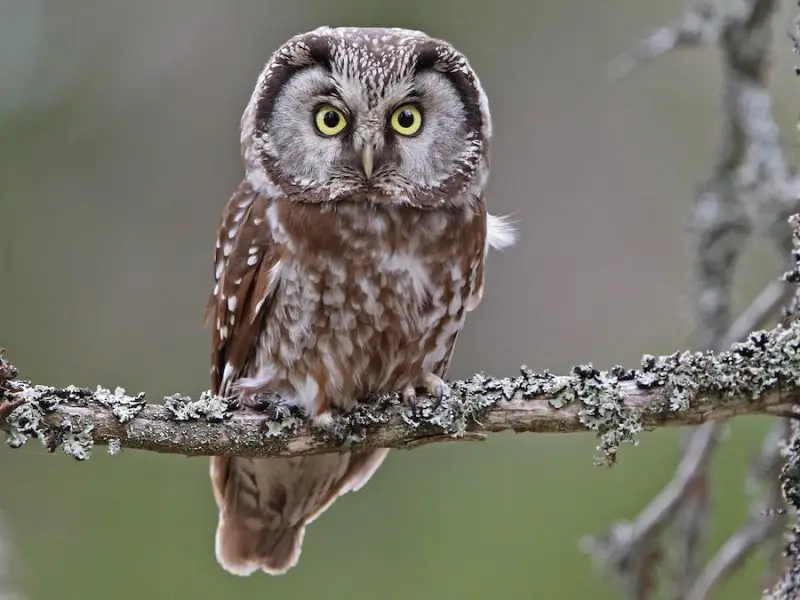
Tengmalm’s Owl is another name for the Boreal Owl, often used in European and some North American literature. It is a small, nocturnal owl with a rounded head and large yellow eyes. Its plumage is a mix of brown and white spots that provide camouflage in dense boreal forests.
Its vocalizations consist of a series of rapid, high-pitched toots that are commonly heard during the breeding season at night. This owl is secretive and prefers the deep, dark forests where it roosts quietly during the day.
Tengmalm’s Owl feeds mainly on small mammals like voles and mice, hunting by flying low through the forest and using keen hearing to detect prey beneath leaf litter and snow. It nests in tree cavities or old woodpecker holes.
In Alaska, Tengmalm’s Owl inhabits boreal forests mainly in the interior and northern parts of the state. It is an important predator in the ecosystem, helping control rodent populations in these remote forested areas.
Elf Owl (Micrathene whitneyi)
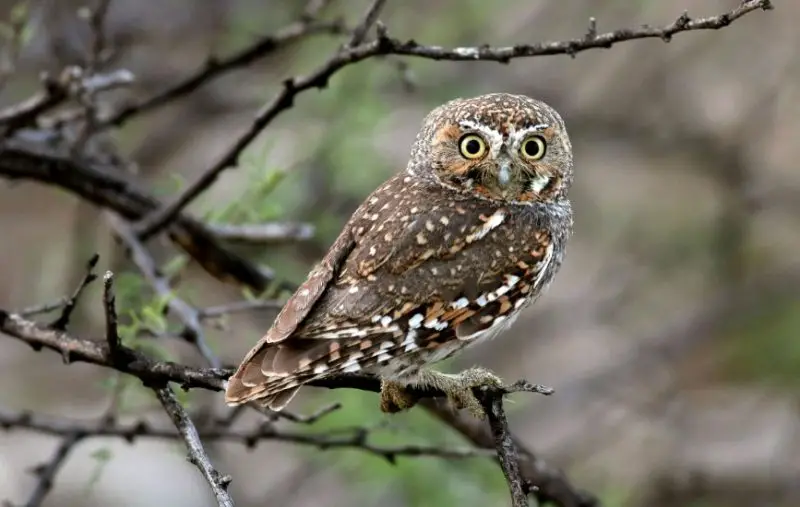
The Elf Owl is one of the smallest owl species in the world, measuring only about five to six inches in height. It has a rounded head with no ear tufts and soft, grayish-brown plumage. Its diminutive size and secretive nature make it rarely observed, especially in Alaska.
This owl produces a series of high-pitched, short whistles and chirps that can be heard mainly during the breeding season at night. It is primarily nocturnal and uses its vocalizations for communication and territory defense.
Elf Owls feed mostly on insects, including moths and beetles, as well as small reptiles. They are agile hunters, catching prey in mid-air or gleaning from tree bark. They nest in old woodpecker holes or natural cavities, preferring arid and semi-arid environments.
In Alaska, the Elf Owl is very rare and considered a vagrant, occasionally recorded in the southernmost parts of the state. Its presence is generally transient, making it a fascinating but uncommon species for bird enthusiasts.
Northern Pygmy Owl (Glaucidium gnoma)
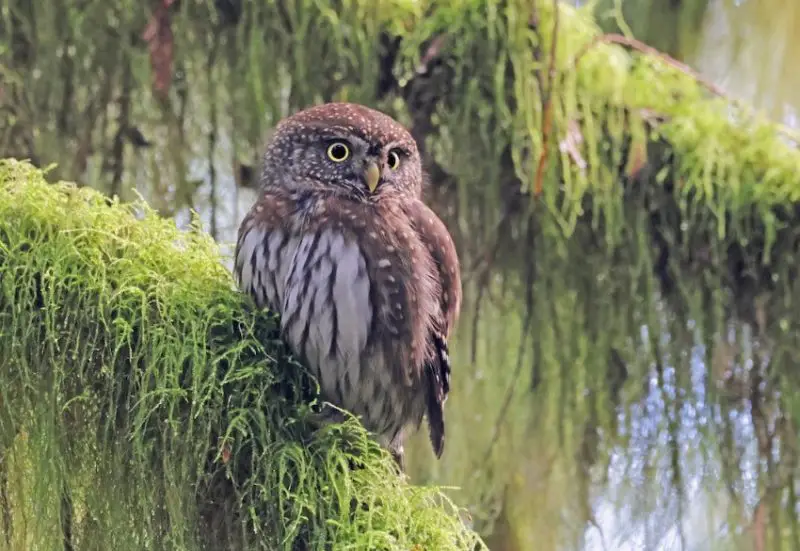
The Northern Pygmy Owl is a small, daytime-active owl with a compact body and rounded head. It lacks ear tufts and has a distinctive spotted and barred pattern on its brownish-gray feathers. Its bright yellow eyes and aggressive behavior distinguish it from other small owls.
This owl is known for its high-pitched, repetitive whistle calls that it uses to communicate and defend its territory. Unlike many owls, the Northern Pygmy Owl is diurnal, hunting actively during the day.
Northern Pygmy Owls prey on small birds, insects, and rodents, hunting from perches in open woodlands and forest edges. They are known for their boldness and sometimes aggressive defense of their territory despite their small size.
In Alaska, the Northern Pygmy Owl is less common and mainly found in southern forested regions. Its shy nature and relatively limited distribution make it a less frequently observed species in the state.

